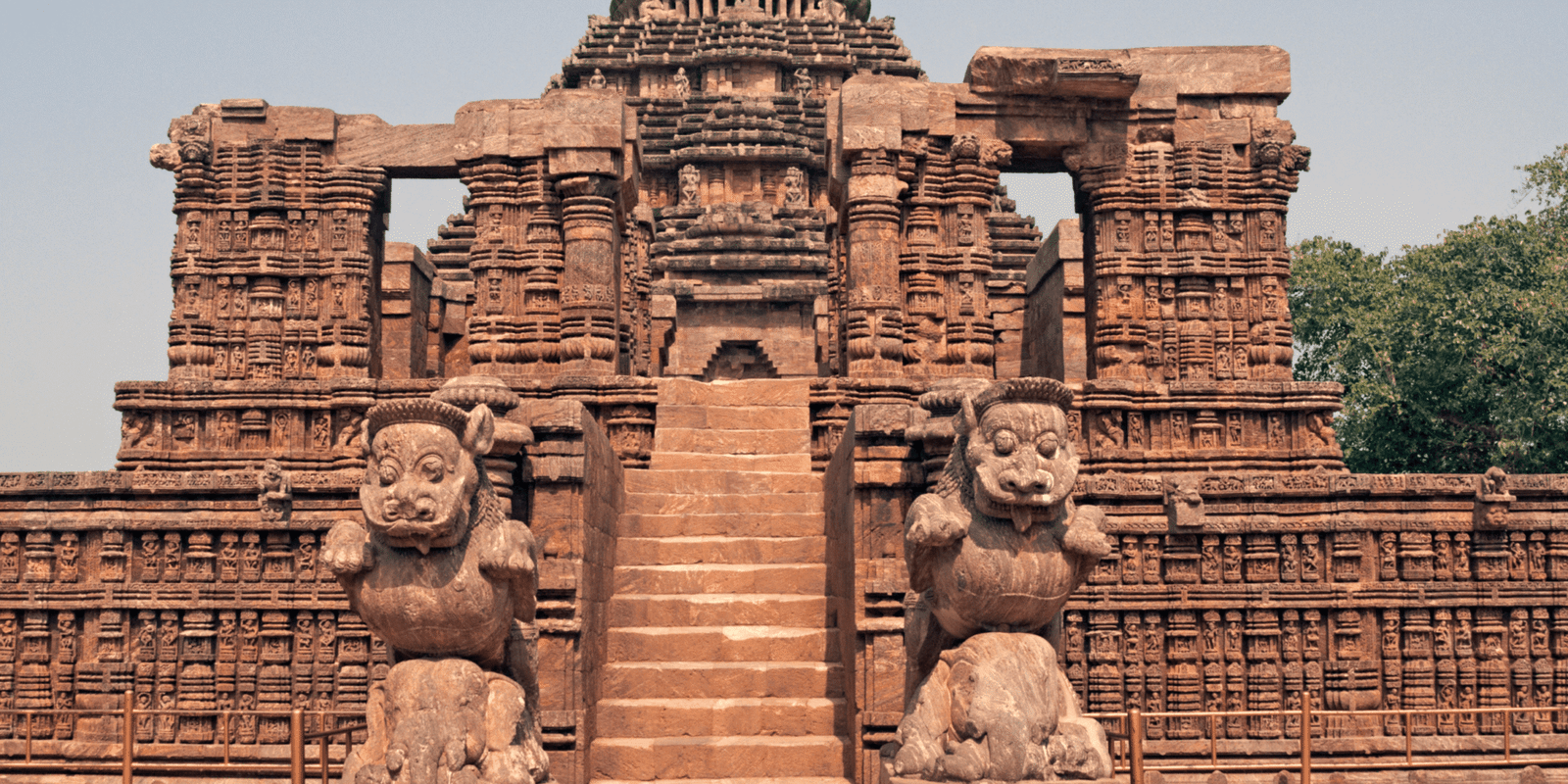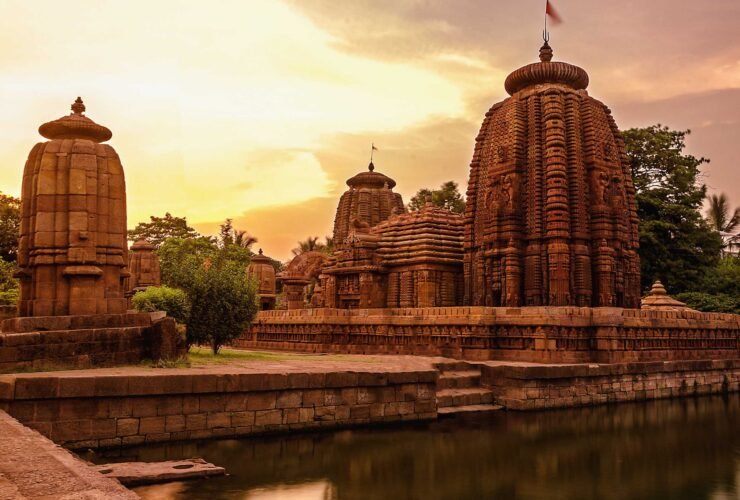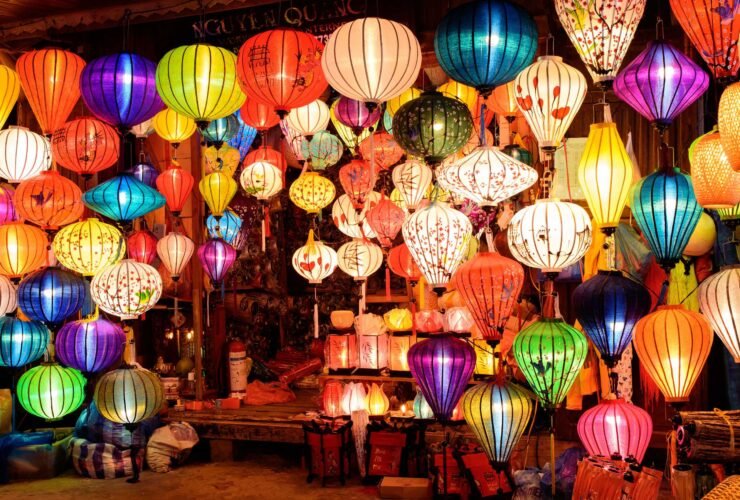The Konark Sun Temple is not just another monument in India. It is a living masterpiece carved in stone, a symbol of time, and a cultural beacon that has stood tall for more than 750 years.
This UNESCO World Heritage Site sits in the coastal town of Konark, Odisha. Sailors of the olden days called it the “Black Pagoda” because they used its darkened silhouette as a navigational landmark.
The temple was built in the 13th century. It is a grand chariot dedicated to Surya, the Sun God. Its architectural brilliance continues to draw historians, travellers, artists, and pilgrims from around the world. From its colossal wheels to its intricate sculptures, the Konark Sun Temple is an ode to India’s artistic and spiritual legacy.
Did you know that there are only a handful of temples dedicated to Lord Surya, and the Konark Sun Temple is the most prominent one?
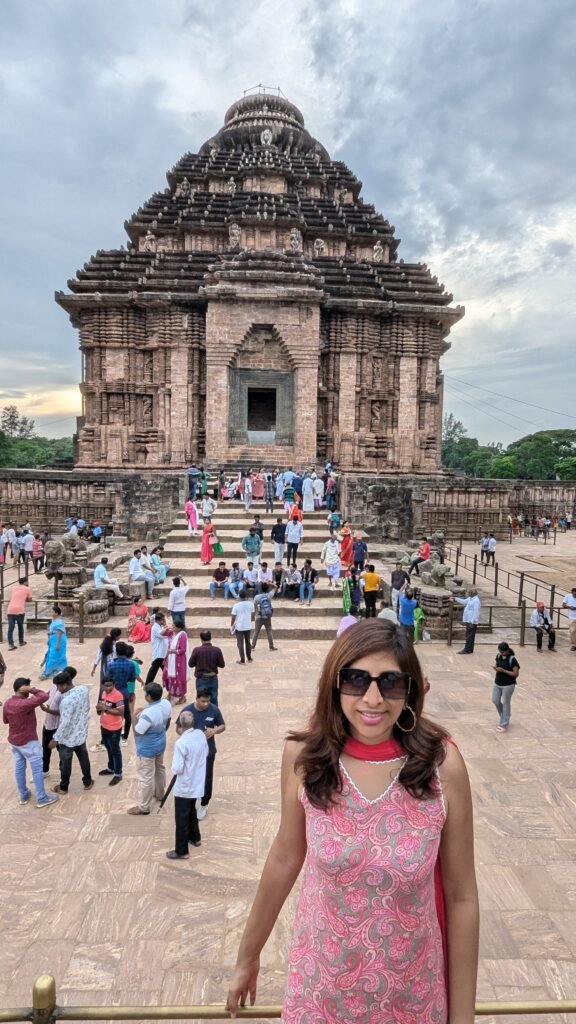
This guide will take you through everything you need to know. It covers the temple’s history, architecture, cultural essence, practical travel tips, nearby attractions, and more. This information will help you make the most of your visit to this timeless wonder.
For those planning a broader trip, our Odisha Unveiled Tour takes you to Konark Sun Temple along with other highlights of Odisha.
1. Historical Background
King Narasimhadeva I of the Eastern Ganga dynasty commissioned the Konark Sun Temple in 1255 CE. According to inscriptions, the king built the temple to celebrate his military victory over Muslim invaders. He also built it as a mark of devotion to Surya, the Sun God.
The structure was designed as a colossal chariot. It has 24 wheels and seven galloping horses. These symbolise the Sun God’s celestial journey across the sky. Legends add a layer of mystery to the temple.
Did you know that local folklore tells of a 52-ton magnet that was once installed at the top of the temple? People believed it held the entire structure together and caused compasses of passing ships to malfunction. Fascinating, right?
Time, invasions, and natural forces have led to the partial ruin of the temple. However, what remains today still offers a breathtaking glimpse into its original grandeur.
2. Architectural Significance
The Konark Sun Temple is one of the most remarkable architectural creations in India. It was built in the traditional Kalinga style of architecture.
The temple was designed in the form of a gigantic stone chariot. Seven horses pull this chariot, which rests on 24 intricately carved wheels.
Each wheel measures about 12 feet in diameter. The wheels have carvings that also function as sundials. Even today, you can estimate the time of day by observing the shadows cast on the wheels. The seven horses symbolise the days of the week. The 24 wheels represent the hours of the day or the months of the year, depending on interpretation.

Did you know that the temple has been built in a way that the first rays of the morning sun strike the main sanctum, illuminating the deity?
The temple walls are a visual library of medieval Indian life. They show everything from mythological stories and celestial beings to everyday scenes. The walls also depict dancers, musicians, animals, and even erotica. Like Khajuraho, the erotic sculptures here symbolise fertility, prosperity, and the celebration of life.
UNESCO inscribed it as a World Heritage Site. The organisation recognised it as a crown jewel of Indian art and architecture.
3. Cultural and Spiritual Importance
The Konark Sun Temple is no longer an active place of worship. The word “temple” remains in its name. Today, it stands as a protected monument. It is a symbol of Odisha’s rich cultural heritage. Unlike functioning temples, there is no dress code here. Visitors are free to keep their footwear on inside the complex.
Its importance lies in the cultural and historical identity it represents. The motifs and symbols of Konark are deeply woven into Odisha’s traditions. They feature in Odissi dance, literature, painting, and even the state emblem of Odisha. For locals, Konark is more than an ancient structure. It is a timeless reminder of the state’s artistic mastery and glorious past.
4. UNESCO World Heritage Status
The Sun Temple at Konark became a UNESCO World Heritage Site in 1984. UNESCO recognised it not just for its architectural magnificence but for its cultural and spiritual significance as well.
The organisation also honoured the symbolism it carries. The temple celebrates time, cosmic order, and the eternal journey of the sun.
The Archaeological Survey of India (ASI) continues preservation efforts. These include structural support, controlled entry, and awareness programs. These measures protect this treasure from further deterioration.
5. Major Attractions Inside the Konark Sun Temple Complex
- The Chariot-Shaped Main Temple
The highlight of Konark is the colossal stone chariot of Lord Surya. This magnificent structure features 24 intricately carved wheels, each over 3 meters in diameter, symbolising time and the solar calendar. The temple was once believed to be pulled by seven stone horses, representing the days of the week, making it a grand symbol of cosmic order and divine power. - The Natya Mandapa (Dancing Hall)
Standing in front of the main temple, the Natya Mandapa is adorned with detailed sculptures of celestial dancers and musicians. These carvings beautifully reflect Odisha’s strong tradition of classical dance and music, showcasing the cultural vibrancy that flourished alongside the temple’s grandeur. - Erotic Sculptures
Like Khajuraho, Konark is also famous for its sensual carvings, which symbolise fertility, life, and the celebration of love. Beyond their symbolic meaning, these sculptures highlight the artistic freedom and openness of the era, making the temple not only a place of worship but also an artistic masterpiece. - The Mayadevi Temple
Within the complex lies the Mayadevi Temple, a smaller shrine dedicated to Goddess Mayadevi, the consort of Lord Surya. This temple actually predates the main shrine and provides an important glimpse into earlier architectural styles and spiritual traditions. - The Vaishnava Temple
On the northern side of the Konark complex stands the Vaishnava Temple, a smaller shrine dedicated to Vaishnavite deities. Archaeological findings here include sculptures of Varaha, the boar incarnation of Vishnu, along with Balarama and Trivikrama (the Vamana avatar), adding further layers of diversity and depth to the sacred complex.
6. Best Time to Visit Konark Sun Temple
The ideal time to visit Konark is during the winter months, from October to February. The weather is pleasant and perfect for exploring during this time. The cooler temperatures allow you to walk around the vast temple complex without exhaustion. That’s why the Transforming Travels Odisha trip in November aligns perfectly with the season.
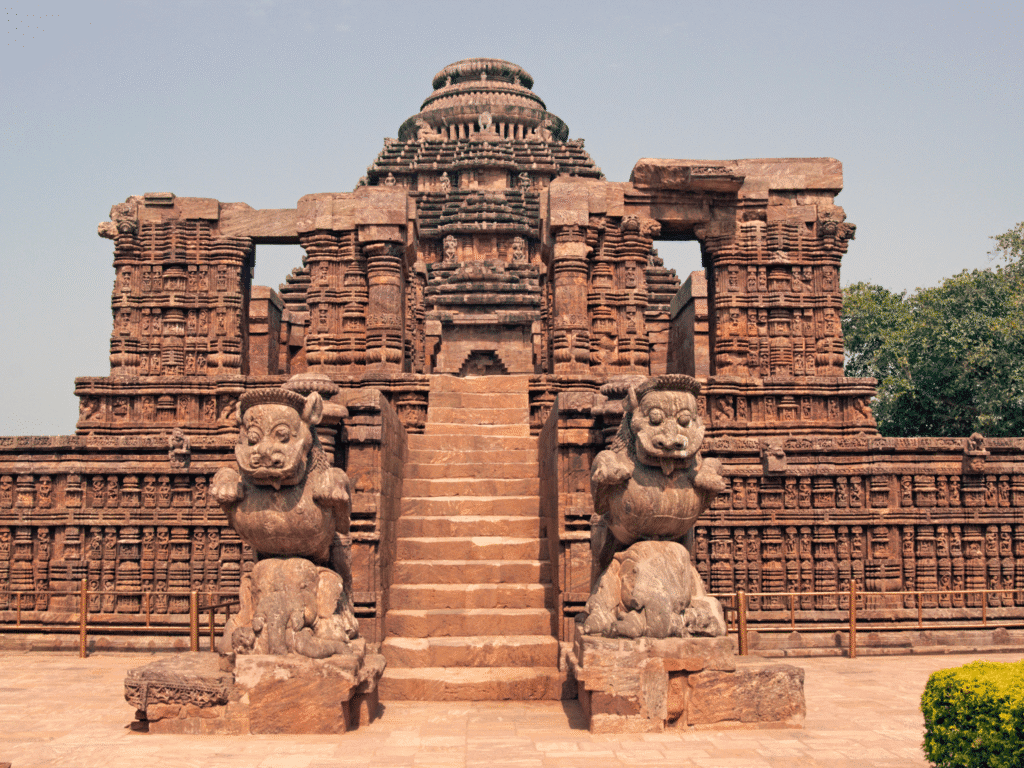
December is a particularly magical time to visit. The Konark Dance Festival takes place during this month. Classical dance forms like Odissi, Bharatanatyam, Kathak, and Kuchipudi are performed.
Dancers perform against the illuminated backdrop of the temple. This creates a visual and cultural delight.
Summers (March to June) are hot and humid. Monsoons (July to September) bring heavy rains that can hinder sightseeing.
7. How to Reach Konark Sun Temple
Konark is well connected to major cities in Odisha and beyond:
- By Air: Biju Patnaik International Airport in Bhubaneswar is the nearest airport. It is about 64 km away. From there, you can hire taxis or take buses.
- By Rail: Puri is the closest railway station at 35 km. It is well-connected to cities like Kolkata, Delhi, and Chennai. Bhubaneswar station (65 km) is another option.
- By Road: Regular buses and cabs connect Konark to Puri, Bhubaneswar, and Cuttack. The drive along the Marine Drive Road from Puri to Konark is particularly scenic. It skirts the Bay of Bengal.
Local transport options include auto-rickshaws, cycle rickshaws, and hired taxis for convenience.
8. Entry Details & Visitor Information
- Timings: The temple is open from 6:00 AM to 8:00 PM every day.
- Entry Fee: Indian citizens pay ₹40. Foreign tourists pay ₹600. Children below 15 years enter free.
- Guides: Certified guides are available at the entrance. Hiring one enriches the experience. They explain carvings and hidden stories.
- Photography: Photography is allowed. Drone photography requires special permission.
- Facilities: Drinking water, restrooms, and seating areas are available near the complex.
9. Light & Sound Show at Konark Sun Temple
In the evenings, visitors can enjoy a spectacular light and sound show held inside the temple complex. Using lights, narration, and music, the show brings the history, legends, and architectural marvels of the Sun Temple.
It’s a memorable way to experience the monument after dark, but keep in mind:
- If you’ve already explored the temple with a licensed guide, much of the content may feel repetitive.
- The show usually ends around 8:30 – 9:00 PM. If you are staying in Puri, you will likely reach your hotel close to 10 PM or later.
Hence, be mindful while deciding whether to watch the light & sound show or not.
10. Konark Dance Festival
The Konark Dance Festival is a highlight of visiting Konark. It is held annually in December.
The five-day festival brings together renowned classical dancers from across India. Performances take place under the starlit sky.
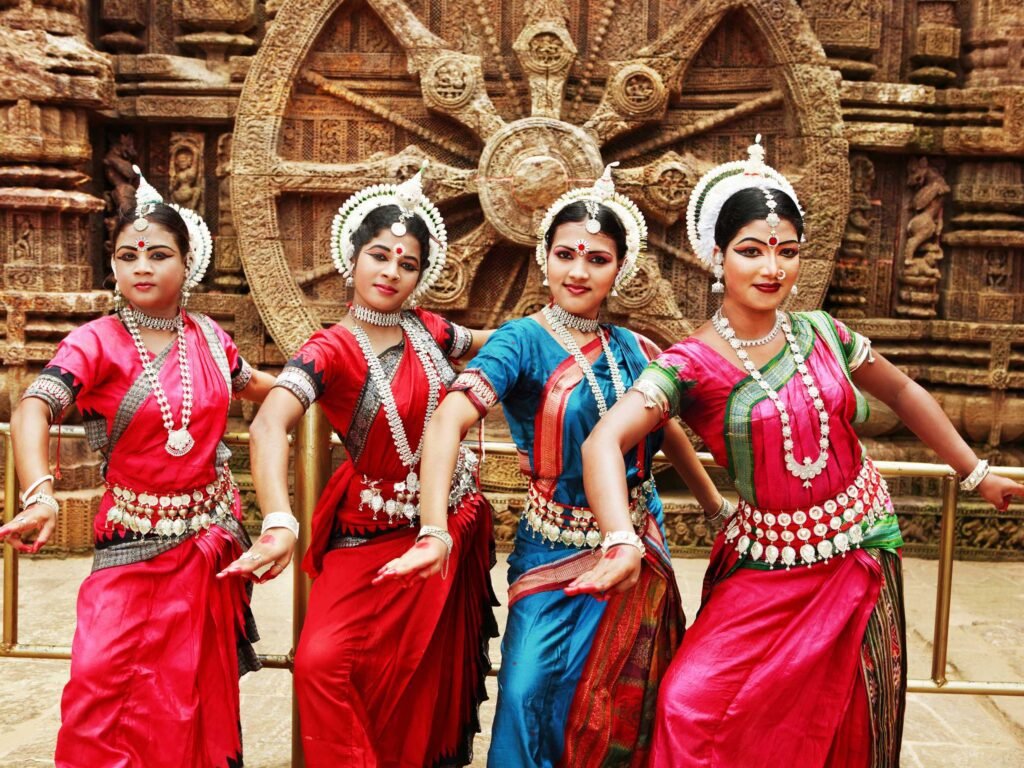
The illuminated Sun Temple serves as the backdrop. Dancers perform Odissi, Kathak, Bharatanatyam, Kuchipudi, and Manipuri. These performances create a mesmerising atmosphere.
The Handicrafts Mela is held alongside the festival. Local artisans showcase traditional crafts, textiles, and souvenirs at this event.
11. Nearby Places to Visit Around Konark Sun Temple
1. Indian Oil Foundation Museum (Konark Sun Temple Museum)
Located right next to the Konark Sun Temple, the Indian Oil Foundation Museum, also called the Arka Kshetra Interpretation Centre, offers a modern, immersive perspective on the temple’s history and artistry.
Spread across 5 acres, it features interactive displays, 3D models, and multimedia exhibits that bring the Sun Temple’s legacy to life. Visitors can also enjoy a captivating 15-minute animated documentary highlighting its mythology, construction, and architectural marvels.
This museum complements the ASI Archaeological Museum by providing a contemporary interpretation, making it ideal for travellers who want a detailed understanding of the temple before exploring the ruins. Photography is restricted inside, and casual tourists can skip it if short on time.
2. ASI Archaeological Museum (Konark Sun Temple ASI Museum)
Managed by the Archaeological Survey of India, this museum preserves original sculptures, panels, and artefacts recovered from the temple complex.
Unlike the Indian Oil Museum, it focuses on traditional preservation and offers an authentic archaeological experience.
Ideal for history enthusiasts, researchers, or anyone interested in the craftsmanship behind the Sun Temple. Regular tourists may skip it if pressed for time, but it is highly recommended for those seeking in-depth knowledge.
3. Chandrabhaga Beach
Just 3 km from the temple, Chandrabhaga Beach is a serene coastal escape known for its golden sands and stunning sunrise views over the Bay of Bengal.
Once considered sacred for ritual bathing, it is now perfect for morning walks, meditation, or photography. Enjoy Chandrabhaga Beach for its breezy charm and stunning coastline, but keep in mind that the waves are strong and the water turns deep quickly, so swimming isn’t advised.
Local vendors offer snacks, handicrafts, and souvenirs, giving visitors a taste of coastal Odisha’s culture. Every December, the Konark Beach Festival adds music, dance, and traditional performances to the landscape, creating a lively cultural experience.
4. Chaitanya Stone Carving Village
A short drive from Konark, this artisan village preserves Odisha’s centuries-old stone carving tradition. Skilled craftsmen here replicate motifs seen on the Sun Temple, using chisels and traditional techniques passed down through generations.
Visitors can observe artisans at work, learn the history behind each design, and even purchase sculptures ranging from small souvenirs to larger decorative pieces. This village provides a unique cultural insight, making it a must-visit for art enthusiasts, photographers, and anyone fascinated by traditional craftsmanship.
5. Puri – Jagannath Temple & Beaches
Jagannath Puri Temple is just about 35 km from Konark. It is one of the most sacred pilgrimage cities in India. The iconic Jagannath Temple is the centrepiece of the city. This temple is dedicated to Lord Jagannath, who is a form of Lord Vishnu.
The annual Rath Yatra (Chariot Festival) draws millions of devotees. Puri also offers more than spirituality. The city’s golden beaches provide stunning sunrises and sunsets. This makes Puri a perfect blend of devotion and leisure.
12. Travel Tips for Visitors
- Visit early in the morning or late in the afternoon for the best lighting and to avoid crowds.
- Carry water, sunscreen, and a hat. Exploring requires walking under open skies.
- Wear comfortable footwear. The temple grounds are expansive.
- Respect the monument. Do not touch or climb the sculptures.
- Hire a guide to uncover hidden details and legends.
- If you plan to attend the Konark Dance Festival, book your accommodation well in advance.
13. Where to Stay and Eat
Konark itself has a few budget and mid-range hotels. That’s why most visitors prefer staying in Puri (35 km) or Bhubaneswar (65 km). These cities offer a wide range of luxury and budget options.
For food, try local Odia delicacies. These include Dalma (lentils with vegetables), Pakhala Bhata (fermented rice with curd), and Chhena Poda (caramelised cheese dessert). Seafood curries are also popular. Street-side stalls near the temple offer snacks such as pakoras and chaats.
14. Shopping & Souvenirs
There is a huge street market right outside the Konark Sun Temple. If you are running less on time during your trip, then it’s a wonderful place to pick up local handicrafts, souvenirs, jewellery, cashews, magnets, etc. One can also find miniature stone carvings inspired by the Sun Temple’s motifs, palm-leaf engravings (Tala Pattachitra), silver filigree jewellery, and handwoven Ikat textiles from Odisha.
Street vendors around the temple sell small trinkets, while government emporiums and craft fairs in Puri or Bhubaneswar offer authentic, higher-quality products. Supporting these artisans helps preserve Odisha’s rich craft traditions.
15. Sustainability & Preservation
As a responsible traveller, it’s important to contribute to preserving this heritage:
- Avoid littering inside or around the temple.
- Do not deface or damage the carvings.
- Support local artisans by purchasing handicrafts.
- Use eco-friendly practices when staying or dining in the area.
- Your mindful visit ensures that future generations can continue to marvel at Konark’s splendour.
Conclusion
The Konark Sun Temple is more than stone and sculpture. It is poetry in architecture, a celebration of time, and a spiritual landmark. It bridges India’s glorious past with its present.
Whether you are a history buff, a cultural enthusiast, or a traveller seeking inspiration, Konark will leave an indelible impression.
The temple offers many experiences. Its majestic wheels tell the time. The intricate carvings narrate stories of life, love, and divinity. Each sculpture speaks of the artistic mastery of ancient craftsmen. The temple stands as a testament to human creativity and devotion.
As you leave Konark, you carry with you more than photographs. You take home a piece of India’s soul. The memories of this architectural marvel will inspire you long after your visit. The Sun Temple teaches us that true greatness lies in creating something that outlives us all.
Plan your visit to Odisha’s Konark Sun Temple today. Let this timeless wonder awaken your sense of wonder. Allow it to connect you with India’s incredible heritage. The chariot of the Sun God awaits to take you on an unforgettable journey through time, art, and spirituality.

